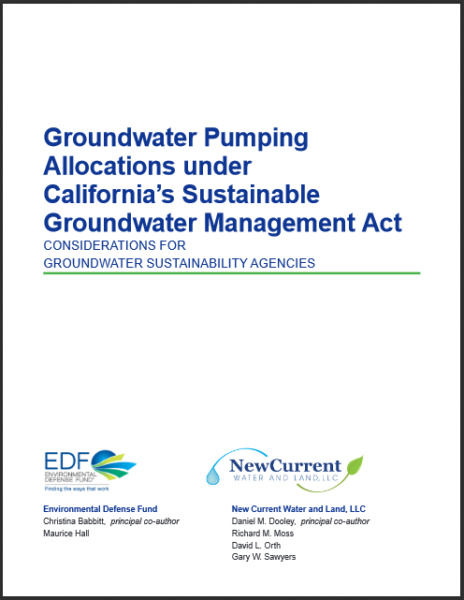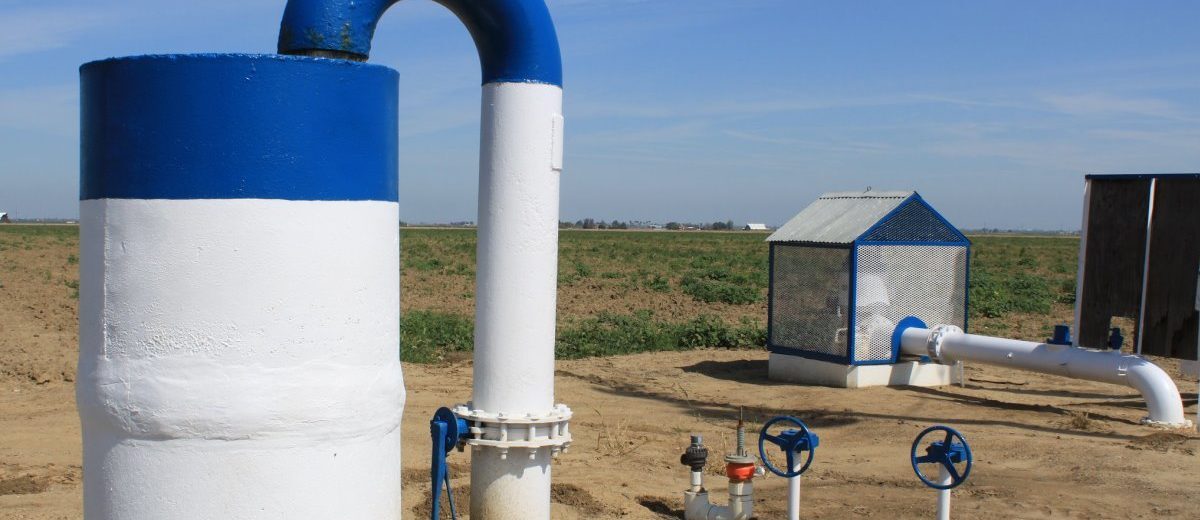 In some basins, GSAs may choose to develop groundwater allocation schemes to ensure that GSPs meet their sustainability goal and avoid state intervention.
In some basins, GSAs may choose to develop groundwater allocation schemes to ensure that GSPs meet their sustainability goal and avoid state intervention.
Groundwater allocation schemes are not new in California; they have been used in several groundwater adjudications and when developed properly can be the basis for successful water markets. Groundwater allocations may take a variety of forms. The most common groundwater allocations are based on acreage or crop based volumes, or historical pumping. More recent groundwater allocation schemes have set aside water for environmental users and for unexercised groundwater rights.
Key information
Sharing Groundwater: A Robust Framework and Implementation Roadmap for Sustainable Groundwater Management in California
From Duke University:
 This working paper offers a framework and roadmap for development of a robust groundwater-sharing system consistent with California’s Sustainable Groundwater Management Act, which requires communities in priority areas to prepare groundwater sustainability plans. The proposed system draws on global experience.
This working paper offers a framework and roadmap for development of a robust groundwater-sharing system consistent with California’s Sustainable Groundwater Management Act, which requires communities in priority areas to prepare groundwater sustainability plans. The proposed system draws on global experience.
Robustness is its signature feature. Opportunities are maximized by a suite of robust local governance, allocation, and administrative arrangements. Additionally, the proposed system incentivizes innovation, stimulates investment, and facilitates low-cost adjustment to changes in groundwater demand.
Among the dynamic components underlying this sharing system are a share register that records ownership and transfers of ownership in the basin’s available shares. These unit shares are fungible; each represents a proportional stake in access to the basin’s groundwater resources. Volumetric allocations are made in proportion to the number of shares held during determined periods throughout the water year. These allocations are recorded in bank-like water accounts, affording account holders an efficient means to manage their resource but also ensuring that they cannot use more than is available. Unused water can be saved for later use.
At the start of the transition to the new system, users are given an allocation buffer so that they have flexibility and time to adjust. Those who want to can make quick non-contestable trades at low cost.
Groundwater Pumping Allocations under California’s Sustainable Groundwater Management Act
From the Environmental Defense Fund:
 In many subbasins, groundwater overdraft conditions will require GSAs to impose reductions in pumping in order to achieve sustainable conditions in the subbasin. To do this, GSAs will need set a limit or “cap” on the overall amount of groundwater that is removed from the subbasin, assigning portions of this capped amount to groundwater pumpers in the form of a pumping allocation.
In many subbasins, groundwater overdraft conditions will require GSAs to impose reductions in pumping in order to achieve sustainable conditions in the subbasin. To do this, GSAs will need set a limit or “cap” on the overall amount of groundwater that is removed from the subbasin, assigning portions of this capped amount to groundwater pumpers in the form of a pumping allocation.
Making pumping allocation decisions will be a difficult task for GSAs, as it will require restricting access to groundwater resources upon which the agricultural community, cities and towns, and others depend. SGMA expressly does not create or adjust groundwater rights and the basic law of groundwater rights remains largely unchanged. Simply put, this means that while GSAs are tasked with managing groundwater with the goal of bringing groundwater conditions into balance and stopping further depletions and other undesirable impacts, they do not have the authority to change or modify groundwater rights. Thus, GSAs should be mindful of the basic law of groundwater as articulated by the common law and a series of adjudicatory court decisions over the last 100 plus years.
The subject of this paper is how to address this dilemma, with the reasoning that if GSAs devise groundwater allocation schemes in a manner consistent with the fundamental principles of groundwater law, the schemes are likely to be more durable, and GSAs are more likely to achieve sustainable groundwater management in a legally defensible manner.
Water and the future of the San Joaquin Valley
From the Public Policy Institute of California (PPIC):
 The state’s Sustainable Groundwater Management Act (SGMA) requires local water users to bring groundwater use to sustainable levels by the early 2040s. This will have a broad impact on valley agriculture and the regional economy in coming years—likely including some permanent idling of farmland.
The state’s Sustainable Groundwater Management Act (SGMA) requires local water users to bring groundwater use to sustainable levels by the early 2040s. This will have a broad impact on valley agriculture and the regional economy in coming years—likely including some permanent idling of farmland.
This report explores three key challenges facing the San Joaquin Valley and reviews the most promising approaches to address them:
Balancing water supplies and demands. To close the groundwater deficit, groundwater sustainability agencies in the valley’s overdrafted basins will have to augment supplies, reduce demands, or use some combination of these two approaches. A range of options are under consideration but they are not equally effective or practical.
Addressing groundwater quality challenges. Poor groundwater quality impairs drinking water supplies in disadvantaged rural communities, reduces long-term agricultural prosperity, and degrades ecosystems. Providing safe drinking water is an urgent priority. Over the longer term, parties will also need to manage water quantity and quality together, to take advantage of synergies and avoid unintended consequences. The necessary coordination will be challenging because the various programs addressing valley water quality issues are carried out by numerous local and regional entities, whose lines of responsibility and geographic boundaries do not neatly align.
Fostering beneficial water and land use transitions. Effectively addressing water scarcity and the resulting land use changes in the San Joaquin Valley offers opportunities to put lands coming out of production to good use—and gain “more pop per drop” from limited water resources. Multiple-benefit approaches to water and land management can enhance groundwater recharge and improve air and water quality. They can also promote healthier soils, new recreational opportunities, additional flood protection, improved habitat, and new revenue streams for private landowners engaging in conservation-oriented management.
Pumping allocation articles on Maven’s Notebook
- Notebook pumping allocations articles

Explore allocations at the California Water Library
{{ document.post_title }}
{{ document.publisher }} | {{ document.document_date }}
{{ document.post_content_short }}





